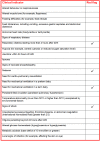Antepartum Membrane Stripping in GBS Carriers, Is It Safe? (The STRIP-G Study)
- PMID: 26719985
- PMCID: PMC4697801
- DOI: 10.1371/journal.pone.0145905
Antepartum Membrane Stripping in GBS Carriers, Is It Safe? (The STRIP-G Study)
Abstract
Objective: Stripping of the membranes is an established and widely utilized obstetric procedure associated with higher spontaneous vaginal delivery rates, reduced need for formal induction of labor and a lower likelihood of post-term pregnancy. Due to the theoretical concern of bacterial seeding during the procedure many practitioners choose not to sweep the membranes in Group B Streptococcus (GBS) colonized patients. We conducted 'the STRIP-G study' in order to determine whether maternal and neonatal outcomes are affected by GBS carrier status in women undergoing membrane stripping.
Study design: We conducted a prospective study in a tertiary referral center, comparing maternal and neonatal outcomes following membrane stripping among GBS-positive, GBS-negative, and GBS-unknown patients. We compared the incidence of composite adverse neonatal outcomes (primary outcome) among the three study groups, while secondary outcome measure was composite adverse maternal outcomes.
Results: A total of 542 women were included in the study, of which 135 were GBS-positive, 361 GBS-negative, and 46 GBS-unknown status. Demographic, obstetric, and intra-partum characteristics were similar for all groups. Adverse neonatal outcomes were observed in 8 (5.9%), 31 (8.6%), and 2 (4.3%) in the GBS-positive, GBS-negative, and unknown groups, respectively (P = 0.530), (Odds Ratio between GBS-Positive vs. GBS-Negative groups 0.67 (95%, CI = 0.30-1.50)); while composite adverse maternal outcomes occurred in 9 (6.66%), 31 (8.59%), and 5 (10.87%) in the GBS-positive, GBS-negative, and unknown groups, respectively (P = 0.617).
Conclusions: Antepartum membrane stripping in GBS carriers appears to be a safe obstetrical procedure that does not adversely affect maternal or neonatal outcomes.
Conflict of interest statement
Figures



Similar articles
-
[Detection of maternal colonization of group B streptococcus in late pregnancy by real-time polymerase chain reaction and its effect on perinatal outcome].Zhonghua Fu Chan Ke Za Zhi. 2010 Jan;45(1):12-6. Zhonghua Fu Chan Ke Za Zhi. 2010. PMID: 20367919 Chinese.
-
Vaginal streptococcus B colonization is not associated with increased infectious morbidity in labor induction.Acta Obstet Gynecol Scand. 2021 Aug;100(8):1501-1510. doi: 10.1111/aogs.14154. Epub 2021 May 2. Acta Obstet Gynecol Scand. 2021. PMID: 33768531
-
[Study on perinatal group B Streptococcus carriers and the maternal and neonatal outcome].Zhonghua Fu Chan Ke Za Zhi. 2000 Jan;35(1):32-5. Zhonghua Fu Chan Ke Za Zhi. 2000. PMID: 11831947 Chinese.
-
Preventing neonatal group B streptococcal infection. Intrapartum antibiotic prophylaxis in some high-risk situations.Prescrire Int. 2011 Mar;20(114):72-7. Prescrire Int. 2011. PMID: 21648230 Review.
-
[Do we need a different approach to GBS screening?].Ginekol Pol. 2014 Jun;85(6):456-60. doi: 10.17772/gp/1753. Ginekol Pol. 2014. PMID: 25029812 Review. Polish.
Cited by
-
Effectiveness of Single Fetal Membrane Sweeping in Reducing Elective Labor Induction for Postdate Pregnancies (38+0 to 40+6 Weeks): A Randomized Controlled Trial.Cureus. 2024 Apr 11;16(4):e58030. doi: 10.7759/cureus.58030. eCollection 2024 Apr. Cureus. 2024. PMID: 38738107 Free PMC article.
-
Membrane stripping in group B streptococcus carriers does not impede adequate intrapartum antibiotic prophylaxis: a retrospective study.Front Med (Lausanne). 2024 Apr 5;11:1368998. doi: 10.3389/fmed.2024.1368998. eCollection 2024. Front Med (Lausanne). 2024. PMID: 38646549 Free PMC article.
-
Review of Evidence-Based Methods for Successful Labor Induction.J Midwifery Womens Health. 2021 Jul;66(4):459-469. doi: 10.1111/jmwh.13238. Epub 2021 May 13. J Midwifery Womens Health. 2021. PMID: 33984171 Free PMC article. Review.
-
High prevalence of Group B Streptococcus colonization among pregnant women in Amman, Jordan.BMC Pregnancy Childbirth. 2019 May 20;19(1):177. doi: 10.1186/s12884-019-2317-4. BMC Pregnancy Childbirth. 2019. PMID: 31109301 Free PMC article.
-
Dinoprostone vaginal insert (DVI) versus adjunctive sweeping of membranes and DVI for term induction of labor.J Obstet Gynaecol Res. 2021 Sep;47(9):3171-3178. doi: 10.1111/jog.14907. Epub 2021 Jun 23. J Obstet Gynaecol Res. 2021. PMID: 34162016 Free PMC article.
References
-
- Swann O. Induction of labor by stripping membranes. Obstetrics and gynecology. 1958;11(1):74–8. - PubMed
-
- Thiery M BC, Keirse MJNC. The development of methods for inducing labour Effective Care in Pregnancy and Childbirth.: Chalmers I, Enkin M, Keirse MJ, editors. Oxford; Oxford University Press; 2000.
-
- McColgin SW, Bennett WA, Roach H, Cowan BD, Martin JN Jr., Morrison JC. Parturitional factors associated with membrane stripping. American journal of obstetrics and gynecology. 1993;169(1):71–7. - PubMed
-
- de Miranda E, van der Bom JG, Bonsel GJ, Bleker OP, Rosendaal FR. Membrane sweeping and prevention of post-term pregnancy in low-risk pregnancies: a randomised controlled trial. BJOG: an international journal of obstetrics and gynaecology. 2006;113(4):402–8. - PubMed
MeSH terms
LinkOut - more resources
Full Text Sources
Other Literature Sources
Medical

